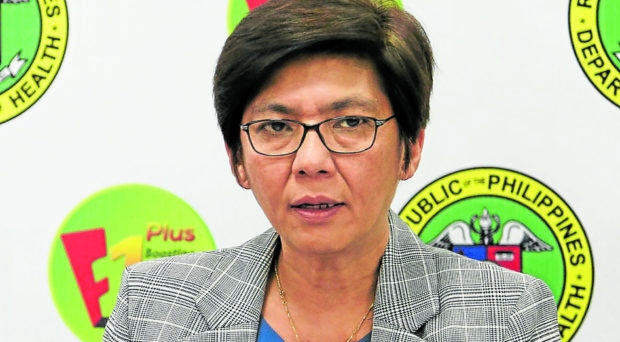MANILA, Philippines — With Europe seeing a rapid spike in new coronavirus cases partly due to “pandemic fatigue,” the Department of Health (DOH) on Wednesday advised the public to accept that “little sacrifices” have to be made to avoid a surge in infections.
Health Undersecretary Maria Rosario Vergeire said the DOH understood the fatigue everyone was going through these days because of the restrictions put in place to control the spread of the virus. But people, she said, must also understand that they can no longer return to life as they knew it prior to the pandemic.
“That’s why we have the new normal. We have to remember that this new normal comes with little sacrifices like always wearing a mask, face shield, practicing distancing and washing hands,” Vergeire said.
A number of European countries like France, Italy, Spain, Germany and the United Kingdom are currently seeing a fresh wave of new infections, and experts partly attribute this to pandemic fatigue, or the public feeling less motivated to observe health measures against COVID-19, the severe respiratory disease caused by the new coronavirus.
It is to be expected, Vergeire said, that when the economy gradually reopens, new cases may rise. But she stressed that this can be tempered through strict compliance with health measures.
“If all of us will cooperate and enforce compliance to these minimum health standards, hopefully this wouldn’t happen to us. We are gradually reopening the economy while balancing everything to prevent this kind of situation from happening in the country,” she said.
Vergeire reiterated that the number of new cases isn’t the sole factor that the government considers in imposing stricter lockdowns. The main determinant, she said, is if a particular community’s health system is able to cope with the increase.
“We’re not just looking at the numbers… If an area sees a rise in cases but their health system is able to cope up, the utilization rate [of critical care facilities] is low, testing is appropriate, and there is efficient contact tracing, a recommendation for stricter quarantine measures may not be necessary,” Vergeire said.
The Octa Research group earlier proposed that stricter quarantine measures be imposed in Bauan, Batangas; Calbayog, Western Samar; and General Trias, Cavite, due to the rising cases there in the last two weeks.
Ventilation guidelines
With regards to the “one-seat-apart” rule that will be imposed in public vehicles, Vergeire clarified that the distancing measure “wasn’t really eased” as this was only meant to better communicate the guideline.
But to help ensure this wouldn’t cause a spike in cases, Vergeire reminded the Department of Transportation “to strictly enforce” the guidelines the DOH had issued on proper ventilation in enclosed spaces, such as avoiding the use of recirculated air in vehicles.
On Wednesday, DOH reported 1,910 additional coronavirus cases, bringing the national tally to 346,536.
Of the new cases, 1,639 got sick between Oct. 1 and 14, while 207 fell ill in September. Metro Manila accounted for a third of the new infections, 624, followed by Cavite (219), Batangas (104), Rizal (91) and Negros Occidental (63).
In the first 14 days of the month, a total of 17,574 cases were recorded nationwide. New infections dropped by 35 percent compared to the same 14-day period last month, when there were 27,324 new cases.
It was also an improvement from the Aug. 1-14 period, when 31,942 cases were recorded.
More deaths
The DOH said 579 more patients had recovered, pushing the overall number of COVID-19 survivors to 293,860. The death toll, however, climbed to 6,449 with the deaths of 78 more patients.
Of the newly reported fatalities, 64 died this month, 10 in September, one each in August and July, and two in June.
Thirty-five of the fatalities were from Metro Manila, 12 from Calabarzon, seven from Central Luzon, six from Northern Mindanao, five from Western Visayas, three from Ilocos, three from Davao, two from the Bangsamoro Autonomous Region in Muslim Mindanao, and one each from Bicol, Central Visayas, Eastern Visayas, Zamboanga and Soccsksargen.
The recoveries and deaths left the country with 46,227 active cases, of which 84.5 percent were mild, 10.5 percent asymptomatic, 1.6 percent severe, and 3.3 percent critical.
As of Wednesday noon, a total of 3,976,980 patients have been tested for the coronavirus by the 147 accredited laboratories.
The DOH also cautioned the people who had recovered, saying they shouldn’t be complacent and think they were already immune to COVID-19.
Reinfection
Vergeire said the health agency was documenting all possible cases of reinfection as reports of recovered people getting sick again increased across the globe, with the second infection reportedly more severe.
“We are now asking for data from all of our areas so that we could better study this. These [reported cases] are all experiential. It still has to be completed to become an official study for us to have enough evidence,” Vergeire said.
“For now, we are providing information to those who have had COVID-19 that there is no immunity passport. Just because you have fallen ill before doesn’t mean you would no longer get [the virus],” she added.
Earlier, World Health Organization Director General Tedros Adhanom Ghebreyesus said that while most patients developed an immune response to the disease, the UN agency still did not know how long it could last.
“[W]e don’t know how strong or lasting that immune response is, or how it differs for different people. We have some clues, but we don’t have the complete picture,” Tedros said.
That, he said, is why it’s important for the public to continue practicing respiratory etiquette, observing physical distancing, and avoiding crowded, close-contact and confined spaces to avoid being infected. INQ


